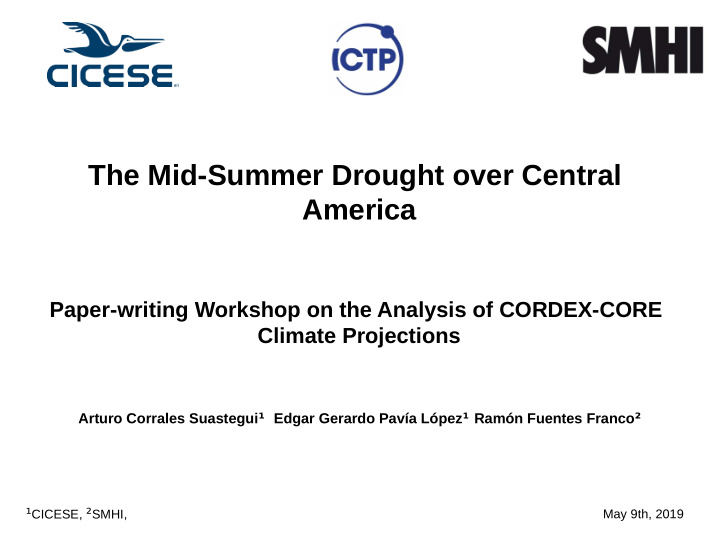



The Mid-Summer Drought over Central America Paper-writing Workshop on the Analysis of CORDEX-CORE Climate Projections Arturo Corrales Suastegui ¹ Edgar Gerardo Pavía López ¹ Ramón Fuentes Franco ² ¹ CICESE, ² SMHI, May 9th, 2019
Introduction The enhanced differential warming between the Pacific (PO) and Atlantic Oceans (AO) (PO-AO) towards the end of the century, which might cause a strengthening of the westward Caribbean Low-Level Jet (CLLJ), which in turn might carry precipitation towards the ocean leading to severe drought over the SMCA region. m
Introduction Climatology of precipitation (1979-2003) +1 std Mid-summer Drought (MSD) -1 std Small et al. (2007)
Methods -Precipitation Data Monthly fields from two datasets: CRU and CHIRPS -Model ICTP Regional Climate Model (RegCM4) Central America domain (CORDEX) -Simulations Reference (1976-2005) and future periods (2070-2099) RegCM4 driven by ERA-Interim as an evaluation of the model (M0) (1981-2015)
Methods To analyze simulations driven by three GCMs from the CMIP5 1. Met Office Hadley Centre MOHC-HadGEM2-ES (M1), 2. Max Planck Institute for Meteorology (MPI-M) M-MPI-ESM-MR (M2), 3. NOAA-Geophysical Fluid Dynamics Laboratory NOAA-GFDL-ESM2M (M3), Table 1.
Methods -The MSD To decide whether or not a year presented a MSD condition we followed a criterion similar to that of Karnauskas et al. (2013); that is, considering monthly data, we decided on a MSD season when there were two precipitation peaks separated from each other by one to three months (the relative dry months). If there were three precipitation peaks (two next to each other), the third precipitation peak should be separated by at least two, and up to four months, from the first peak; otherwise the year was considered as a No-MSD.
Methods -The MSD We define three quantities: 1) The annual intensity ( I ) where k = 1, 2, ..., n is the year, m = 1, 2, 3, is the length of the relative dry period, Pp 1 is the sum of the precipitation of the two peaks bordering the relative dry months, and Pp 2 is the total precipitation during the relative dry months.
Methods 2) The Frequency ( F ) where Oc k is the occurrence in year k (Oc k = 1 for MSD years, and Oc k = 0 for No-MSD years). 3) The area coverage ( Ar ) where i = 1, 2, ..., p is the grid point number, and p is the total number of grid points.
Methods -Ensembles To define ensembles of precipitation, SST and zonal wind at 850 hPa (u850) by averaging the corresponding monthly fields of the simulations in Table 1 (Eref, Ercp2.6 and Ercp8.5). From the precipitation ensembles we will calculate the annual cycle, I , F and Ar .
Preliminary results of the evaluation of the model (M0) (1981-2015)
RegCM4 driven by EIN75 Precipitation (mm/d) CRU CHIRPS M0
CHIRPS CRU Spatial distribution of MSD I M0 Spatial dsitribution of CHIRPS CRU MSD F (%) M0
CRU CHIRPS M0 m (%) 71 70 70 std (%) 16 11 18
Correlation between intensity and the seasonal mean MJJASO of iCLLJ index during the a) CRU b) CHIRPS evaluation period. a) CRU, b) CHIRPS and c) M0 are the correlation I-iCLLJ. c) M0 Black contours are significant correlations. iCLLJ index. EIN75 (red) M0 (blue)
The observations show that the intraseasonal precipitation variability accounts for nearly 40% of the total variability of precipitation along the Pacific coast and some regions of south-central Mexico and ~30% over Yucatan peninsula. % % CHIRPS M0 The ratio between the standard deviation of 20-80 day filtered MJJASO precipitation to standard deviation of the unfiltered precipitation.
Global distribution of locations with biannual cycle of precipitation Karnauskas et al. 2013
The Bimodal Precipitation Distribution in the Upper Midwest Keables, Michael J. 1989
Thanks
Recommend
More recommend